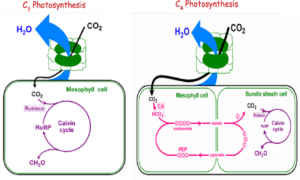C3 plants are defined as the plants that exhibit the C3 pathway. These plants use the Calvin cycle in the dark reaction of photosynthesis. The leaves of C3 plants do not show kranz anatomy. Here the photosynthesis process takes place only when the stomata are open. Approximately 95% of the shrubs, trees, and plants are C3 plants.
On the other hand, C4 plants are defined as the plants that use the C4 pathway or Hatch-slack pathway during the dark reaction. The leaves possess kranz anatomy, and the chloroplasts of these plants are dimorphic. About 5% of plants on earth are C4 plants.
Click Here for Complete Biology Notes
What are C3 Plants
A typical plant on the earth that uses photosynthesis is a C3 plant. Photosynthesis is the process when carbon dioxide enters a plant through its stomata, and the enzyme Rubisco fixes carbon into sugar using the Calvin cycle. It fuels plant growth. This fixation of carbon dioxide by rubisco is the first step of the Calvin cycle. The plants that use this mechanism of carbon fixation are called C3 plants. Approx 95% of plants on the earth are C3 plants. They are also known as temperate plants.
The photosynthesis process can take place only when the micropores (stomata) on leaves are open. The leaves of C3 plants do not show kranz anatomy. C3 plants exhibit the C3 pathway. It is the three-carbon compound (3-PGA). Here the first carbon compound produced has three carbon atoms.
The Calvin cycle is useful to convert CO2 into carbon. It eliminates greenhouse gas (CO2) from the atmosphere efficiently. Calvin cycle helps plants to store energy for a more extended period.
C3 plants are highly rich in proteins. They can be annual perennial. Some of the C3 plant examples are wheat, rye, oats, orchard grass.
What are the C4 Plants?
C4 plants possess a particular type of leaf anatomy. They use Phosphoenolpyruvate carboxylase (PEP enzyme) instead of photorespiration to enter the Calvin cycle. Enzymes of C4 metabolism are regulated by light. PEP enzyme is more attracted to CO2 molecules and reacts less with O2 molecules. PEP carboxylase does not tend to bind oxygen.
This process takes place in the mesophyll cells (spongy cells in the middle of the leaf) instead of the stomata where CO2 and O2 enter the plant. The light-dependent reaction occurs in mesophyll cells, and the Calvin cycle occurs in bundle-sheath cells around the leaf veins. Carbon dioxide present in the atmosphere is fixed in the mesophyll cells to form a pure 4-carbon organic acid (oxaloacetate) by the non-rubisco enzyme.
The 4-carbon organic acid is then converted to a similar molecule, called malate, that can be transported into the bundle-sheath cells. Inside the bundle-sheath cells, malate breaks down and releases a molecule of CO2.
Difference between C3 Plants and C4 Plants
[ninja_tables id=”3917″]Similarities between C3 and C4 Plants
There are also a few similarities between the C3 and C4 plants:
- Both the plants fix energy from sunlight.
- Both synthesize carbohydrates.
- They are the type of dark reactions of photosynthesis.
- The site of photosynthesis is chloroplast in both types of plants.
Related Posts
- Phylum Porifera: Classification, Characteristics, Examples
- Dissecting Microscope (Stereo Microscope) Definition, Principle, Uses, Parts
- Epithelial Tissue Vs Connective Tissue: Definition, 16+ Differences, Examples
- 29+ Differences Between Arteries and Veins
- 31+ Differences Between DNA and RNA (DNA vs RNA)
- Eukaryotic Cells: Definition, Parts, Structure, Examples
- Centrifugal Force: Definition, Principle, Formula, Examples
- Asexual Vs Sexual Reproduction: Overview, 18+ Differences, Examples
- Glandular Epithelium: Location, Structure, Functions, Examples
- 25+ Differences between Invertebrates and Vertebrates
- Lineweaver–Burk Plot
- Cilia and Flagella: Definition, Structure, Functions and Diagram
- P-value: Definition, Formula, Table and Calculation
- Nucleosome Model of Chromosome
- Northern Blot: Overview, Principle, Procedure and Results

















